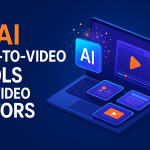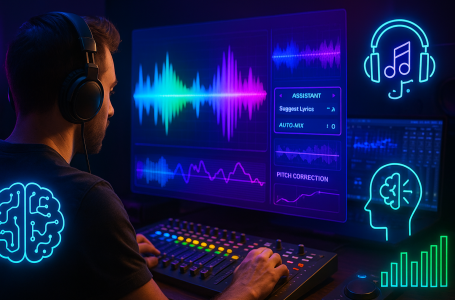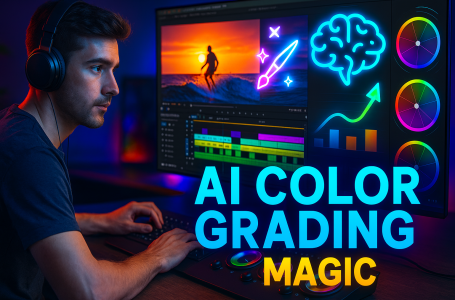
The video editing landscape has transformed dramatically, and if you’re still hunting down voice actors for every project or recording your own shaky voiceovers, you’re burning daylight and budget. AI voice agents aren’t just another tech trend – they’re becoming essential tools that solve real problems video editors face daily.
As someone who’s spent countless hours syncing audio, dealing with inconsistent voice talent, and scrambling to meet impossible deadlines, I’ve watched AI voice technology evolve from robotic text-readers to sophisticated tools that can genuinely enhance your creative workflow. Let’s dive into how these tools can revolutionize your editing process.
Who Is the Video Editor? (Profile Overview)
The modern video editor is a content creation powerhouse. Whether you’re cutting together YouTube vlogs, crafting TikTok hooks, producing corporate training videos, or editing documentary footage, your role extends far beyond simply arranging clips on a timeline.
Today’s editors work across multiple platforms simultaneously. You might start your morning editing a 20-minute YouTube deep-dive, pivot to creating fifteen 30-second Instagram Reels from that same footage, then spend your afternoon on a corporate explainer video that needs to be delivered in three languages by tomorrow.
Your daily tasks include color correction, audio mixing, motion graphics, storytelling through pacing, and increasingly – managing voiceovers and narration. That last part has become crucial because voice drives engagement. A compelling narrator can transform a mediocre video into something viewers actually finish watching.
But here’s the challenge: traditional voiceover workflows are broken for modern video production. You need multiple takes, different emotional tones, maybe three different languages, and you need it all yesterday. Voice actors are expensive, scheduling is a nightmare, and recording your own voice means dealing with acoustics, microphone technique, and the fact that you might not have “the voice” for every project.
The explosion of short-form content has made this worse. When you’re creating dozens of videos per week, the old model of hiring professional voice talent becomes unsustainable. Meanwhile, clients and audiences expect that same polished, professional sound they’d get from a Netflix documentary – but on a YouTube budget and TikTok timeline.
What’s Changing in the Workflow?
The shift is massive. Five years ago, a video editor might work on a handful of long-form projects per month. Now, you’re potentially creating hundreds of pieces of content, each requiring unique voiceover treatment.
Short-form content dominates, but it still needs professional narration. A 60-second explainer video might require four different voice segments, each with distinct emotional beats. Multiply that across the 50 videos you’re editing this month, and suddenly voice production becomes your biggest bottleneck.
International expansion is no longer optional. Brands want their content localized, not just translated. That means finding native speakers for multiple languages, coordinating recording sessions across time zones, and maintaining consistent quality standards across all versions.
Tight deadlines have become the norm. Clients expect same-day turnarounds on social content. When a trending topic emerges, you have hours – not days – to capitalize on it. Traditional voice production timelines simply don’t work in this environment.
Many editors have found themselves becoming one-person production studios. You’re expected to handle everything from initial concept to final delivery, including voice work. But not everyone has the equipment, space, or vocal skills to consistently deliver professional-quality narration.
This is where AI voice agents step in, not as a replacement for human creativity, but as tools that eliminate the logistical nightmare of voice production while maintaining quality standards.
Try: Best AI Title Generator Tools
How AI Voice Agents Help Video Editors
AI voice technology has reached a tipping point where it genuinely solves workflow problems rather than creating new ones. These tools generate professional-quality voiceovers from scripts in minutes, not hours or days.
The customization capabilities are game-changing. You can adjust tone, pacing, emotional inflection, and even accent to match your video’s context. Need an enthusiastic tech explainer? Done. Documentary-style gravitas? Easy. Conversational podcast feel? No problem.
Multi-language support means you can create localized versions without sourcing voice talent in each target market. The same script becomes professional narration in English, Spanish, French, or Mandarin with consistent quality across all versions.
Revisions happen in real-time. If a client wants the narrator to sound “more excited” or “slightly slower,” you make the adjustment and regenerate in seconds. No more scheduling additional recording sessions or trying to match the original audio’s room tone.
Real-world use cases I’ve implemented:
YouTube Channel Intros: Consistent brand voice across hundreds of episodes without hiring a voice actor for every batch.
Explainer Videos: Multiple character voices for complex topics, each with distinct personality traits that support the narrative.
Corporate Training: Multilingual versions that maintain the same professional tone and pacing across all languages.
Documentary Narration: Authoritative, measured delivery that matches the visual pacing perfectly.
Social Media Content: Quick turnaround voiceovers for trending topics, allowing rapid content deployment.
TikTok and Instagram Reels: Automated voice generation for script-to-video workflows, enabling high-volume content creation.
The elimination of technical barriers is huge. No microphone setup, no acoustic treatment, no retakes because of background noise or vocal fatigue. The audio quality is consistent every time.
System Setup for Seamless Use of AI Voice Agents
Most AI voice tools are surprisingly accessible from a system requirements perspective. The heavy lifting happens in the cloud, so you don’t need a powerhouse workstation.
Minimum requirements for most tools: 4GB RAM, dual-core processor, and stable internet connection. Even budget laptops from the last three years handle these tools smoothly.
Recommended setup: 8GB RAM, quad-core processor, and reliable broadband. This ensures smooth operation when working with longer scripts or batch processing multiple files.
Cloud-based vs. software-based: Cloud tools dominate this space because they leverage powerful server infrastructure for voice generation. This is actually advantageous for editors working on various machines or collaborating with remote teams. Your voice library and projects sync across devices.
Browser requirements: Most tools work in modern browsers (Chrome, Firefox, Safari, Edge). Some offer dedicated desktop applications, but browser-based access is typically more convenient for video editors who already live in web-based collaboration tools.
File output: Standard audio formats (MP3, WAV, FLAC) with customizable bitrates and sample rates. Most tools export at broadcast quality (48kHz/24-bit) by default, which integrates seamlessly with professional video editing software.
Video editing software compatibility: Direct integration exists for popular platforms like Adobe Premiere Pro, DaVinci Resolve, and Final Cut Pro. Even without direct integration, the standard audio export formats work universally.
The beauty of this setup is its simplicity. Unlike traditional voice recording, which requires quiet spaces, quality microphones, and audio treatment, AI voice generation works from anywhere with internet access.
Checkout Free Tool: How To Pronounce
22 AI Voice Agent Tools for Video Editors
1. Murf.ai
What It Does: Professional-grade AI voice generation with extensive customization options and voice cloning capabilities.
How It Solves Editor-Specific Problems: Murf addresses the time crunch of modern video production by generating consistent, professional voiceovers in minutes. The platform’s voice cloning feature allows editors to maintain brand consistency across content series.
Minimum System Requirements: 4GB RAM, modern browser, stable internet connection.
Why It’s Important for Video Editors: Offers over 120 voices in 20+ languages with fine-tuned control over pronunciation, pauses, and emphasis – crucial for matching narration to visual pacing.
Key Features:
- Voice cloning for brand consistency
- Script editor with SSML markup support
- Team collaboration features
- API integration for automated workflows
- Commercial licensing included
2. ElevenLabs
What It Does: Advanced AI voice synthesis focusing on emotional range and natural speech patterns, with industry-leading voice cloning technology.
How It Solves Editor-Specific Problems: ElevenLabs excels at creating emotionally nuanced narration that matches video content’s emotional arc, eliminating the need for multiple voice actor sessions.
Minimum System Requirements: 8GB RAM recommended, modern browser, stable internet.
Why It’s Important for Video Editors: The emotional depth and natural cadence make it ideal for documentary work, storytelling content, and character voices in educational videos.
Key Features:
- Premium voice cloning from short audio samples
- Real-time voice conversion
- Advanced emotional tone controls
- Multiple output formats and quality settings
- Enterprise-grade API access
3. Play.ht
What It Does: Comprehensive text-to-speech platform with focus on content creator needs and workflow integration.
How It Solves Editor-Specific Problems: Play.ht streamlines the script-to-audio pipeline with batch processing capabilities, allowing editors to generate multiple voice segments simultaneously.
Minimum System Requirements: 4GB RAM, modern browser.
Why It’s Important for Video Editors: Bulk processing features and affordable pricing make it perfect for high-volume content creation and social media workflows.
Key Features:
- Bulk text-to-speech processing
- WordPress and content management integrations
- Voice speed and pitch fine-tuning
- Multi-language support with native accents
- Affordable subscription tiers
4. Descript Overdub
What It Does: Voice cloning technology integrated within a comprehensive video editing platform.
How It Solves Editor-Specific Problems: Overdub eliminates the need to switch between applications by combining voice generation with video editing, creating a unified workflow.
Minimum System Requirements: 8GB RAM, modern browser or desktop app.
Why It’s Important for Video Editors: The integration of voice generation, transcription, and video editing in one platform reduces context switching and speeds up production.
Key Features:
- Integrated video editing suite
- Automatic transcription and captioning
- Voice cloning with safety protocols
- Collaborative editing features
- Screen recording capabilities
5. WellSaid Labs
What It Does: Enterprise-focused AI voice platform emphasizing natural, conversational speech patterns for professional content.
How It Solves Editor-Specific Problems: WellSaid’s focus on conversational, professional voices solves the challenge of creating corporate and educational content that sounds authentically human.
Minimum System Requirements: 4GB RAM, modern browser.
Why It’s Important for Video Editors: The professional voice quality and enterprise licensing make it ideal for corporate video production and client work.
Key Features:
- Studio-quality voice avatars
- Advanced pronunciation controls
- Enterprise security and compliance
- Custom voice development services
- Multi-user team management
6. Resemble.ai
What It Does: Real-time voice cloning and synthesis with advanced security features and ethical AI protocols.
How It Solves Editor-Specific Problems: Resemble addresses both creative and legal concerns by providing high-quality voice cloning with built-in consent and verification systems.
Minimum System Requirements: 6GB RAM, modern browser.
Why It’s Important for Video Editors: The security features and consent protocols make it suitable for commercial projects where voice rights and authenticity matter.
Key Features:
- Real-time voice conversion
- Deepfake detection and prevention
- Multi-language voice cloning
- API integration for custom workflows
- Enterprise security standards
7. Speechify
What It Does: User-friendly text-to-speech platform with focus on accessibility and ease of use.
How It Solves Editor-Specific Problems: Speechify’s simplicity makes it perfect for editors who need quick voiceovers without extensive customization, ideal for rapid content creation.
Minimum System Requirements: 2GB RAM, basic browser support.
Why It’s Important for Video Editors: The streamlined interface and mobile app support enable voice generation on the go, crucial for responsive content creation.
Key Features:
- Simple, intuitive interface
- Mobile app for on-the-go generation
- Speed control and voice selection
- Document upload and processing
- Affordable personal and commercial plans
8. Replica Studios
What It Does: AI voice platform designed specifically for creative industries, including gaming, film, and content creation.
How It Solves Editor-Specific Problems: Replica’s creative industry focus means voices are optimized for narrative content, character work, and immersive experiences.
Minimum System Requirements: 6GB RAM, modern browser.
Why It’s Important for Video Editors: The platform’s understanding of creative workflows and character voice development makes it ideal for narrative and educational content.
Key Features:
- Character voice development
- Emotional range and expression controls
- Creative industry licensing
- Collaboration tools for creative teams
- Integration with game engines and creative software
9. Listnr
What It Does: Content-focused AI voice platform with podcast and video creator-specific features.
How It Solves Editor-Specific Problems: Listnr addresses the specific needs of content creators with features like automatic podcast generation and social media optimization.
Minimum System Requirements: 4GB RAM, modern browser.
Why It’s Important for Video Editors: The content creator focus includes features like automatic chapter marking and social media clip generation that integrate well with video workflows.
Key Features:
- Podcast-specific voice optimization
- Automatic content segmentation
- Social media clip generation
- Multi-format export options
- Content management and organization tools
10. Lovo.ai
What It Does: Comprehensive AI voice platform with granular control over voice characteristics and extensive voice library.
How It Solves Editor-Specific Problems: Lovo’s extensive customization options allow editors to fine-tune voice characteristics to match specific brand requirements and video styles.
Minimum System Requirements: 4GB RAM, modern browser.
Why It’s Important for Video Editors: The granular control over voice parameters enables precise matching of narration to video content and brand guidelines.
Key Features:
- 500+ voices in 100+ languages
- Granular voice parameter controls
- Voice cloning capabilities
- Team collaboration features
- Commercial licensing options
11. Amazon Polly
What It Does: AWS-powered text-to-speech service with enterprise-grade scalability and integration capabilities.
How It Solves Editor-Specific Problems: Polly’s API-first approach enables automation and integration with existing video production workflows and content management systems.
Minimum System Requirements: API access, minimal local requirements.
Why It’s Important for Video Editors: The scalability and integration capabilities make it ideal for large-scale content production and automated workflow implementation.
Key Features:
- Neural voice technology
- SSML markup support
- Multi-language support
- API integration capabilities
- Pay-per-use pricing model
12. Microsoft Azure Speech Services
What It Does: Enterprise-grade text-to-speech platform with custom voice development and neural voice technology.
How It Solves Editor-Specific Problems: Azure’s enterprise features solve scalability and integration challenges for video production companies and agencies working with large content volumes.
Minimum System Requirements: API access, minimal local requirements.
Why It’s Important for Video Editors: The custom voice development capabilities enable creation of unique brand voices for long-term content series and corporate communications.
Key Features:
- Custom neural voice development
- Real-time speech synthesis
- Multi-language support with regional variants
- Enterprise security and compliance
- Integration with Microsoft ecosystem
13. Google Cloud Text-to-Speech
What It Does: AI-powered speech synthesis with WaveNet technology and extensive language support.
How It Solves Editor-Specific Problems: Google’s platform solves multilingual content challenges with high-quality voices across numerous languages and dialects.
Minimum System Requirements: API access, modern browser for console.
Why It’s Important for Video Editors: The extensive language support and neural voice quality make it ideal for international content localization and global brand consistency.
Key Features:
- WaveNet neural voice technology
- 220+ voices across 40+ languages
- SSML markup support for fine control
- Real-time and batch processing
- Integration with Google ecosystem
14. IBM Watson Text to Speech
What It Does: Enterprise AI speech synthesis with customization features and industry-specific optimizations.
How It Solves Editor-Specific Problems: Watson’s enterprise focus addresses the needs of video production companies requiring consistent quality, security, and integration with business systems.
Minimum System Requirements: API access, modern browser for interface.
Why It’s Important for Video Editors: The customization capabilities and enterprise features make it suitable for corporate video production and branded content series.
Key Features:
- Voice customization and fine-tuning
- Industry-specific voice optimization
- Multi-language support
- Enterprise security standards
- Integration with Watson ecosystem
15. Natural Reader
What It Does: Accessible text-to-speech platform with focus on ease of use and document processing.
How It Solves Editor-Specific Problems: Natural Reader’s document processing capabilities allow editors to quickly convert scripts, articles, and written content into narration.
Minimum System Requirements: 2GB RAM, basic browser support.
Why It’s Important for Video Editors: The document upload and batch processing features streamline the conversion of written content to voiceover assets.
Key Features:
- Document upload and processing
- OCR text recognition
- Simple voice selection interface
- Batch processing capabilities
- Affordable pricing options
16. Voicery
What It Does: High-quality neural text-to-speech with focus on natural conversation and emotional expression.
How It Solves Editor-Specific Problems: Voicery’s conversational AI addresses the challenge of creating natural-sounding dialogue and narrative content.
Minimum System Requirements: 4GB RAM, modern browser.
Why It’s Important for Video Editors: The conversational quality makes it ideal for interview-style content, educational videos, and narrative storytelling.
Key Features:
- Conversational AI technology
- Emotional expression controls
- Multi-speaker dialogue generation
- Natural pause and emphasis patterns
- Commercial licensing options
17. Acapela Group
What It Does: Established text-to-speech provider with extensive voice library and customization options.
How It Solves Editor-Specific Problems: Acapela’s extensive voice library and established technology provide reliable, consistent results for professional video production.
Minimum System Requirements: 4GB RAM, modern browser or desktop software.
Why It’s Important for Video Editors: The proven technology and extensive voice options ensure consistent quality across projects and long-term content series.
Key Features:
- Extensive voice library
- Multiple deployment options
- Voice customization capabilities
- Multi-language support
- Enterprise licensing options
18. CereProc
What It Does: Scottish-based text-to-speech company specializing in character voices and emotional expression.
How It Solves Editor-Specific Problems: CereProc’s character voice specialization addresses the need for distinctive, memorable narration in creative and educational content.
Minimum System Requirements: 4GB RAM, modern browser.
Why It’s Important for Video Editors: The character voice focus and emotional range make it ideal for storytelling, educational content, and brand personality development.
Key Features:
- Character voice specialization
- Emotional expression capabilities
- Custom voice development
- Multi-language support
- Creative industry licensing
19. ReadSpeaker
What It Does: Global text-to-speech provider with focus on accessibility and multilingual content.
How It Solves Editor-Specific Problems: ReadSpeaker’s accessibility focus and multilingual capabilities address the need for inclusive content and global reach.
Minimum System Requirements: 2GB RAM, basic browser support.
Why It’s Important for Video Editors: The accessibility features and extensive language support enable creation of inclusive content that reaches diverse audiences.
Key Features:
- Accessibility-focused design
- Extensive multilingual support
- Easy integration options
- Consistent voice quality
- Global deployment capabilities
20. Neospeech
What It Does: Established TTS provider with focus on high-quality, natural-sounding voices for professional applications.
How It Solves Editor-Specific Problems: Neospeech’s professional focus addresses the quality requirements of corporate and commercial video production.
Minimum System Requirements: 4GB RAM, Windows/Mac compatibility.
Why It’s Important for Video Editors: The professional voice quality and established technology provide reliable results for commercial and corporate video projects.
Key Features:
- Professional voice quality
- Desktop and server deployment
- Voice customization options
- Multi-language support
- Commercial licensing
21. Lyrebird (now Descript)
What It Does: Voice cloning technology that creates personalized AI voices from audio samples.
How It Solves Editor-Specific Problems: Voice cloning enables consistent brand voice across content series and allows for voice matching in post-production scenarios.
Minimum System Requirements: 8GB RAM, modern browser.
Why It’s Important for Video Editors: The voice cloning capability enables brand consistency and solves continuity challenges in long-form content production.
Key Features:
- Personal voice cloning
- Integration with editing tools
- Ethical AI protocols
- High-quality voice synthesis
- Team collaboration features
22. Botika
What It Does: AI voice platform focusing on conversational AI and customer interaction scenarios.
How It Solves Editor-Specific Problems: Botika’s conversational focus addresses the need for natural, interactive-sounding narration in training and educational videos.
Minimum System Requirements: 4GB RAM, modern browser.
Why It’s Important for Video Editors: The conversational AI capabilities enable creation of interactive-feeling content and training materials that engage viewers.
Key Features:
- Conversational AI optimization
- Interactive voice scenarios
- Multi-language conversation support
- Easy integration options
- Business-focused pricing
Comparison Table – AI Voice Tools at a Glance
| Tool Name | Min RAM | Voice Customization | Multi-Language | Free Plan | Export Options | Best For |
|---|---|---|---|---|---|---|
| Murf.ai | 4GB | Extensive | Yes (20+) | Limited | MP3/WAV/FLAC | YouTube, Agencies |
| ElevenLabs | 8GB | Advanced | Yes (Multiple) | Trial | MP3/WAV | Advanced Use, Emotion |
| Play.ht | 4GB | Moderate | Yes (60+) | Yes | MP3/WAV | Bulk Processing |
| Descript | 8GB | Voice Cloning | Limited | Yes | WAV | Integrated Editing |
| WellSaid Labs | 4GB | Professional | Limited | Demo | WAV/MP3 | Corporate Content |
| Resemble.ai | 6GB | Voice Cloning | Yes | Trial | MP3/WAV | Security-Conscious |
| Speechify | 2GB | Basic | Yes | Limited | MP3 | Quick Generation |
| Replica Studios | 6GB | Character Focus | Yes | Trial | WAV/MP3 | Creative Projects |
| Listnr | 4GB | Content-Focused | Yes (75+) | Limited | MP3/WAV | Podcasts, Social |
| Lovo.ai | 4GB | Granular | Yes (100+) | Limited | MP3/WAV | Brand Consistency |
| Amazon Polly | API | SSML Support | Yes (29) | Pay-per-use | MP3/OGG/PCM | Automation |
| Azure Speech | API | Custom Voices | Yes (75+) | Credits | WAV/MP3 | Enterprise |
| Google TTS | API | WaveNet | Yes (40+) | Credits | MP3/WAV/OGG | Multilingual |
| IBM Watson | API | Customizable | Yes (13) | Lite Plan | WAV/MP3/FLAC | Business Integration |
| Natural Reader | 2GB | Basic | Yes (20+) | Limited | MP3/WAV | Document Processing |
| Voicery | 4GB | Conversational | Limited | Trial | WAV/MP3 | Dialogue Content |
| Acapela | 4GB | Extensive | Yes (30+) | Demo | WAV/MP3 | Established Projects |
| CereProc | 4GB | Character Voices | Yes (Multiple) | Trial | WAV/MP3 | Creative Content |
| ReadSpeaker | 2GB | Accessibility | Yes (50+) | Demo | MP3/WAV | Inclusive Content |
| Neospeech | 4GB | Professional | Yes (Multiple) | Trial | WAV/MP3 | Commercial Use |
| Lyrebird | 8GB | Voice Cloning | Limited | Integrated | WAV | Brand Voice |
| Botika | 4GB | Conversational | Yes | Trial | MP3/WAV | Training Videos |
Best Tool by Experience Level Table
| Experience Level | Recommended Tools | Why It’s Ideal |
|---|---|---|
| Beginner | Speechify, Natural Reader, Listnr | Plug-and-play interface, minimal setup, affordable pricing, intuitive controls |
| Intermediate | Murf.ai, Play.ht, Lovo.ai, WellSaid Labs | High-quality voices, moderate customization, good integration options, professional results |
| Expert | ElevenLabs, Descript, Resemble.ai, Amazon Polly | Voice cloning, advanced control, API integration, team workflows, enterprise features |
| Enterprise | Azure Speech, Google TTS, IBM Watson | Custom voice development, scalability, security compliance, business system integration |
Do’s and Don’ts Table for Editors Using AI Voice Agents
| Do’s | Don’ts |
|---|---|
| Customize tone and pace to match visual content | Don’t use default monotone settings for all projects |
| Test voice samples with actual video before full generation | Don’t assume all AI voices work for all content types |
| Manually sync voiceover timing with video pacing | Don’t rely entirely on auto-sync without review |
| Use different voices for different characters or sections | Don’t overuse the same voice across all brand content |
| Check commercial licensing for client work | Don’t skip legal verification for commercial projects |
| Save voice settings for brand consistency | Don’t recreate voice parameters for every project |
| Preview long-form content in segments during generation | Don’t generate hour-long narrations without testing |
| Adjust pronunciation for technical terms and proper names | Don’t ignore pronunciation errors in final output |
| Export in high-quality formats matching your video specs | Don’t settle for compressed audio that degrades in post |
| Keep backup voice options for critical projects | Don’t depend on single AI voice service for important deadlines |
Editor Use Case Summary: Tasks Simplified with AI Voice Tools
Task A: Converting Scripts to Professional Narration Traditional workflow involves finding voice talent, scheduling recording sessions, managing revisions, and dealing with inconsistent audio quality. AI voice agents eliminate these steps entirely. Upload your script, select voice characteristics, and generate broadcast-quality narration in minutes. The consistency is perfect for content series, and revisions happen instantly without additional costs.
Task B: Creating Multilingual Versions Quickly Previously, multilingual content required sourcing native speakers for each language, coordinating multiple recording sessions, and ensuring consistent delivery across all versions. AI tools generate native-quality voices in dozens of languages from the same script. A corporate training video can become available in Spanish, French, Mandarin, and Arabic within hours rather than weeks.
Task C: Saving Budget by Replacing Expensive Voice Actors Professional voice talent costs $200-500 per project for quality work, plus revision fees and studio time. AI voice generation costs pennies per project with unlimited revisions. For high-volume content creators, this represents thousands in monthly savings that can be reinvested in better equipment, marketing, or additional content creation.
Task D: Producing Social Content at Scale Social media demands constant content creation with quick turnaround times. AI voice tools enable rapid script-to-video workflows where trending topics can be turned into engaging content within hours. Batch processing capabilities allow creation of dozens of videos simultaneously, each with perfectly timed narration that matches the platform’s optimal viewing patterns.
These tools run smoothly on mid-range laptops because the processing happens in the cloud. You don’t need expensive studio setups, soundproofing, or professional microphones. A decent internet connection and basic computer handle the entire workflow, making professional voice production accessible to individual creators and small agencies alike.
The reliability factor is crucial – AI voices don’t have bad days, don’t get sick, and don’t require scheduling. When clients demand same-day delivery or when you’re working across time zones, this consistency becomes invaluable.
Final Checklist for Editors
☐ Checked my laptop specs against tool requirements – Verify your system can handle the recommended tools smoothly
☐ Tested free plans or demos – Experience the voice quality and workflow before committing to paid plans
☐ Matched voice tone to video genre – Ensure the AI voice characteristics align with your content style and audience expectations
☐ Aligned timing with scene pacing – Test voice generation with actual video clips to confirm pacing works with your editing style
☐ Exported in high-quality audio formats – Verify output settings match your video production specifications (48kHz/24-bit recommended)
☐ Verified commercial licensing – Confirm usage rights for client work and commercial distribution
☐ Established brand voice consistency – Document voice settings and preferences for ongoing projects and team collaboration
☐ Created backup workflow options – Identify alternative tools and processes for critical project deadlines
☐ Integrated with existing editing software – Test import/export workflows with your primary video editing platform
☐ Developed quality control process – Establish review steps for AI-generated content before final delivery
The video editing landscape will continue evolving, but AI voice agents have already proven their value in solving real workflow problems. They’re not replacing human creativity – they’re eliminating the technical and logistical barriers that prevent you from focusing on what you do best: crafting compelling visual stories.
Whether you’re editing your first YouTube video or managing content for major brands, these tools can transform your voice production workflow from a bottleneck into a competitive advantage. The technology is mature, the costs are reasonable, and the results speak for themselves.
Start with the tools that match your experience level and current needs. As your projects grow in complexity and scale, you can expand into more advanced platforms. The key is getting started and discovering how AI voice generation fits into your unique creative process.
The future of video editing includes AI as a standard tool, not an experimental add-on. Early adopters are already seeing the benefits in faster turnaround times, lower production costs, and the ability to take on projects that would have been impossible with traditional voice production methods.
Try:











